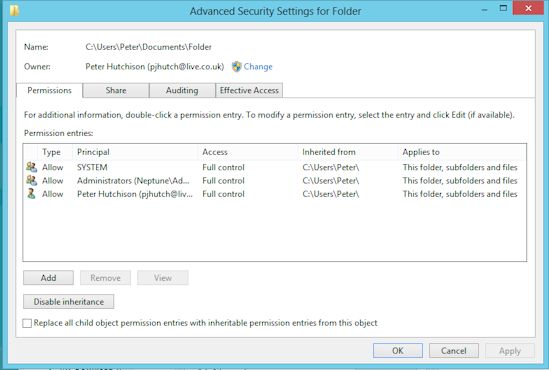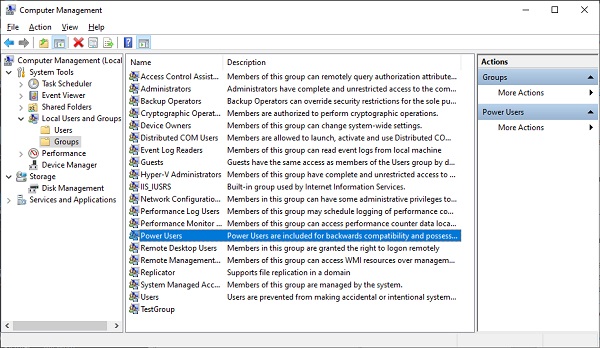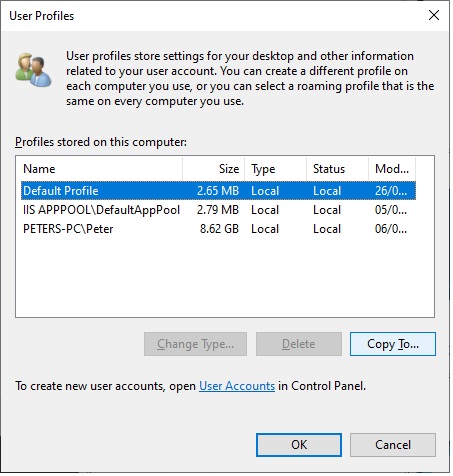
 |
Windows 8.1 FAQ |
1. How do I setup User Accounts in Windows 8.1?
To set up new accounts, open Control Panel (Windows +F, and search in Apps for Control Panel). Select User Accounts and Family Safety and click 'Add or remove user accounts'. To create a new account, click on Manage another Account and then Create a new account. Enter the name of the new account, select whether its a Standard (recommended) or administrator account and click on Create Account.
For accounts you can set or change the password, change the login picture, change the account type and set up Parental Controls if the account is for a child.
If a user forgets their password in the future, you can create a Password Reset disc which can be used on the login screen to regain access.
For Professional or Enterprise, you use the Local Users and Groups (press Windows key + R, and enter lusrmgr.msc) admin tool. Alternatively, open Control Panel, System and Security, Administrative Tools and open Computer Management. Expand Local Users and Groups.
2. What is an Administrator user?
By default windows is installed with one 'administrator' account and a guest account. An administrator account can change any settings on the computer, install drivers, install programs, change file/folder permissions, change entries in the registry and so on. When Windows 8.1 is installed, the user can specify additional accounts with administrator priviledges, when then happens the original 'administrator' account is hidden. The only way to login as 'administrator' is to boot into Safe Mode.
3. What is a Standard User?
A standard user make make changes in their own account such as desktop appearance, themes, create icons on their desktop, run programs and load and save files. They cannot install drivers, install programs or make system wide changes. Windows 8 now allows you to use your Hotmail, Outlook or WindowsLive account to login to Windows 8 which will integrate your account with the Windows Live web resources.
4. How do I set Folder Permissions in Windows 8?
To set permissions in Windows 8.1, select the Desktop app, then open Explorer icon on the task bar. Then browse for the folder, right click the folder and select Properties and
click on the Security tab which shows the current file and folder permissions:

At the top is a list of users and groups, and below is the list of permissions. The permissions are as follows:
Full control - can read,write and change files and change permissions.
Modify - can read, write and change files only.
Read & Execute - can read files and execute program files or scripts.
List folder contents - can view a list of files but cannot view contents of
files
Read - can read contents of files
Write - can create files or folders and change files
Special permissions - combination of permissions set in the Advanced tab for
more granular control.
Advanced tab.

Permissions -Change permissions with more fine tuning and you can turn inherited permissions on or off.
Share - Change the share permissions for the folder.
Auditing -Specify what changes to files and folders are audited and recorded in the Security event viewer log. You also need to enable auditing in the Local Security policy console as well for it to work.
Effective Permissions -Used to view what the actual or effective rights are applied to a given user or group when troubleshooting access issues.
The owner can be changed by clicking on the Change link at the top of the Advanced window.
5. How do I delete old user Profiles?
User profiles are stored in C:\Users. There are special folders called Public
and Default which must NOT be deleted as they contain the a shared
profile for shared documents and a Default user profile used to create new accounts.
Profiles can be deleted via the System Control Panel, select the Advanced
tab and then User Profiles. You can copy or delete profiles here.
6. My profile is corrupt and using a default. How do I fix it?
Create a new account and login with it, then copy the folders from your old
profile into your new profile in C:\Users such as Application Data, Local Settings,
Desktop, Favourites, My Documents, Send To, Start menu but not then ntuser.dat
or ntuser.dat.log files.
7. How do I create a Power User?
A Power User has more permissions than a Standard User and can read/write to
files in C:\Windows or C:\Program Files and make some system changes. This feature
is not available in the standard edition of Windows 8.1. In Professional or Enterprise, you just need to add the
user to the Power Users group via the Computer Management console.

8. How do I customise the Default User?
The Default user profile is used when creating new accounts in Windows 8.
It contains the default settings for all new accounts created on Windows machines.
Usually, when you create a new account and login, the default user's settings
are copied to the new profile, then the user can customise their setup as they
wish. If you wish everyone to have the same settings from the start. You need
to copy the settings to the default user. In Windows 8, you have to use the Administrator user for this.
First, create a new user called NewAdmin, then login with it, logout. Login as administrator and then use
the Control Panel to change the settings as you wish, change the My Documents
location, Screen Savers, backdrops and so on. Then logout when done. Login as
an NewAdmin user and load the System control panel, click on Advanced,
user profile Settings and select the NewUser profile from list, click on Copy
To and browse for C:\Users\Default and click ok to copy settings.
9. I can not log in to Windows 8, I have forgotten my password?
You can use your Password Reset Disk which you created when you first
installed Windows 8 or when you created accounts to reset your password.
If you are using a Hotmail or Windows Live account, you can change it at https://accounts.live.com/password/reset (although you need to login to use a web browser!)
If using a normal Windows 8 account (not Live or Hotmail), and enter the wrong password, click on the Reset Password button and the Reset Password Wizard will start and then you can use a Password Reset Disk to reset your password. The disk can be created when you create your account in the Control Panel, User Accounts.
If you do not have this disk or deleted your user, reboot in Safe Mode by pressing F8 during the boot up sequence and login with the built in Administrator user and use the User Control Panel to change your password or create a new user.
10. I have installed some programs but they do not appear in the Start menu when I login as another user?
In Windows 8.1, most programs will be shown on the new style start menu. To add a new program to this menu, click on right side of the screen, select the top Search button and enter name of the program, for example, Notepad, on the left side, right click the program and new options will appear at the bottom, click on Pin to Start to add it to the Start men. Another option Pick to Taskbar will add it to the desktop taskbar.
Standard program shortcuts can still be found in the ProgramData folder (c:\programdata\Microsoft\Windows\Start menu\Programs).
11. Can I rename my profile folder in C:\Users?
It is possible unfortunately, a lot of Registry entries will point to files and folders in your Profile. It is better to backup your Profile to another directory, as an administrator user, (create one if you only have your own), login, goto System Control Panel, Advanced, User Profiles and select Copy To to copy it to another folder. Then delete your old user account (along with the old profile), create a new user, login as the new user to create a new profile. Then logout and login as an Administrator and copy the profile into your new Users folder.

12. I have some files, they are private and I cannot access them?
You need to grab Ownership of the file, this can be done via the Properties of the folder, click on Security, Advanced, then click on the Change link to change to owner.
13. Can I move folders from C:\Users to another location?
Yes you can, the Documents folder is easiest to move, locate C:\Users\<username>\Documents folder on your hard disk, right click it and select Properties and select the Location tab enter a new directory and click Move.
The Temporary Internet Files can be relocated using the Internet Options control panel (see Settings, Move Folder). Other folders can be changed using a program called X-Setup or use Regedit and change locations in HKEY_CURRENT_USER\Software\Microsoft\Windows\CurrentVersion\ Explorer\ShellFolders. So you can move your Favourites, Cookies and Application Data etc elsewhere.
14. How do I change my password?
You can change it via the User Accounts control panel, the Computer Management console or sometimes via the Ctrl+Alt+Del screen and select Change Password. You can also use the Net user username new_password command to change passwords of a user.
15. How do I turn off or change the User Account Control dialogs?
You can change it in Control Panel, User Accounts and Family Safety, User Accounts and Change User Account Control Settings. There are now four levels to choose from:
a) Always notify (when installing software or when making Windows changes or settings).
b) Default. Only notify me when programs try to make changes to my computer.
c) Notify me only when programs try to make changes to my computer (do not dim the desktop)
d) Never notify me when installing programs or making changes to Windows.
16. How do I enable the built in Administrator account?
In Windows 8, the administrator account is disabled and hidden. To renable access,
open a command prompt using Run as administrator first, then enter:
Net user administrator /active:yes . The account will then be available
on the login screen when you logout. It can also be enable in Local Users and Groups in the Computer Management console.
17. How can I restrict or limit usage for a given user?
You can use Family Safety (see Control Panel, User Accounts and Family Safety, Family Safety) to restict or allow which programs or apss a user can use, you can also limit the time they can use on the computer and control which games they can play using their rating, content or title.